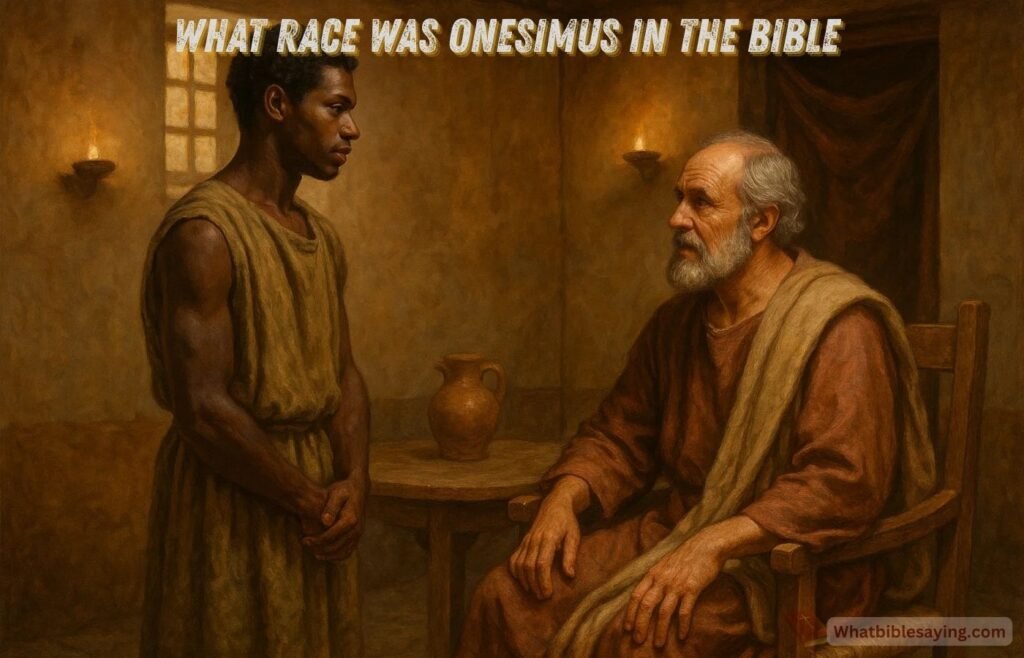 Why the Question Matters
Why the Question Matters
Every time we open the Bible, we encounter real people with real stories. One of those people is Onesimus. His name may not be as familiar as Peter, Paul, or Mary, but his life tells us a lot about God’s love and the power of the gospel to transform hearts.
Some readers wonder: What race was Onesimus in the Bible? What nationality did he belong to? What background did he come from? These questions may sound simple, but they take us into the world of the first-century church, where slaves and masters, Jews and Gentiles, men and women, all heard the same good news of Jesus Christ.
In this article, we’ll carefully walk through what the Bible says about Onesimus, what history can tell us about his background, and what lessons we can learn for our lives today.
Who Was Onesimus?
The name “Onesimus” appears in the Letter to Philemon in the New Testament. This short letter, just 25 verses long, was written by the Apostle Paul while he was in prison. It is addressed to a Christian man named Philemon, who lived in the city of Colossae, in Asia Minor (modern-day Turkey).
Onesimus was Philemon’s slave. At some point, Onesimus ran away from his master. In God’s providence, he ended up meeting Paul, who was under house arrest in Rome. Paul led Onesimus to faith in Christ. From there, the story changes from one of slavery and running away to forgiveness, reconciliation, and brotherhood in Christ.
Paul writes to Philemon asking him to receive Onesimus back “no longer as a slave, but better than a slave, as a dear brother” (Philemon 16).
What Race Was Onesimus in the Bible?
The Bible does not tell us the exact race of Onesimus. It does not describe his skin color, his features, or his ethnicity in detail. And perhaps that is intentional. The gospel breaks down the barriers of race and nationality, reminding us that in Christ, “there is neither Jew nor Greek, slave nor free, male nor female, for you are all one in Christ Jesus” (Galatians 3:28).
Still, we can gather some background from history and context:
Onesimus lived in Colossae – This was a Greco-Roman city in Asia Minor. Many people there were of Greek, Roman, or local Anatolian background.
Slavery in the Roman Empire – Slaves came from many places: Africa, Asia Minor, the Middle East, and Europe. They could be prisoners of war, children born into slavery, or people sold due to debt.
The name “Onesimus” – It means “useful” in Greek. It was a common name for slaves, often given by masters.
Because of this, Onesimus could have been Greek, Phrygian (local Anatolian), or from another region. Some early church traditions suggest he may have had darker skin, possibly of African descent, but the Bible itself is silent.
What Nationality Is Onesimus?
When we ask about nationality in the Bible, we have to remember that “nation” meant something different then than it does today. In the Roman Empire, people were defined by their city, region, or social status more than by modern national borders.
Onesimus was a slave in Colossae. His master Philemon was a Christian man in that same city. That places Onesimus within the Greco-Roman world of Asia Minor. His “nationality,” if we use the term loosely, would have been tied to Colossae and the Roman Empire.
Which Disciple Was Black in the Bible?
This question often comes up alongside Onesimus. People wonder if any of the disciples or early church figures were African. The answer is yes, Africa has always been part of the biblical story.
Simon of Cyrene (Mark 15:21) was from Cyrene in North Africa. He carried Jesus’ cross.
The Ethiopian eunuch (Acts 8:27–39) was a high official who believed in Jesus after Philip explained the Scriptures to him.
Lucius of Cyrene (Acts 13:1) was one of the prophets and teachers in Antioch.
So, the church has always included people of African descent. As for Onesimus, we cannot say for sure if he was African, Greek, or another background. What we do know is that he was welcomed as a brother in Christ.
What Ethnicity Was Philemon?
To better understand Onesimus, we should also ask: What ethnicity was his master, Philemon?
Philemon lived in Colossae, a Roman city. His name is Greek, and scholars generally agree that he was a Gentile (non-Jew). He was a wealthy man with a house large enough for the church to meet in (Philemon 2).
This helps us picture the setting: a Gentile Christian slave owner, a runaway slave who met Paul, and a letter calling for forgiveness and Christian brotherhood.
The Background of Onesimus
Let’s piece together what we know about Onesimus:
Name: Greek name meaning “useful”
Status: Slave belonging to Philemon of Colossae
Journey: Ran away, met Paul in prison, converted to Christ
Future: According to some traditions, Onesimus later became a church leader and even a bishop of Ephesus
That background is powerful. Onesimus was once seen as property, but through Christ, he became a beloved brother and perhaps even a leader in the church.
Why Doesn’t the Bible Tell Us His Race Directly?
It’s natural to wonder why Scripture doesn’t tell us Onesimus’s race. The Bible sometimes describes people’s appearance, but often it does not. That silence can teach us something important:
God’s message is not about dividing people by race or nationality. Instead, it’s about uniting them in Christ. The emphasis in Onesimus’s story is not where he came from or what color his skin was, but what God did in his life.
Lessons From Onesimus’s Story
1. The Gospel Breaks Down Social Barriers
Onesimus was a slave, Philemon was his master, and Paul was an apostle. Yet in Christ, they became brothers.
2. No One Is Too Far Gone
Onesimus ran away, but God found him through Paul. His story reminds us that God can turn our mistakes into testimonies.
3. Forgiveness Is Central to the Christian Life
Paul urged Philemon to forgive and accept Onesimus back as family. That call to forgiveness still speaks to us today.
4. Our Identity Is in Christ, Not in Race or Status
Whether Onesimus was Greek, African, or from somewhere else, his true identity was “a brother in the Lord.”
Early Church Tradition About Onesimus
Some ancient Christian writings suggest that Onesimus later became the bishop of Ephesus, following in the footsteps of Timothy. If true, this would show how far God lifted him, from a runaway slave to a shepherd of God’s people.
While not every detail can be proven, the tradition highlights how the early church valued Onesimus as a faithful servant of Christ.
How Onesimus’s Story Speaks to Us Today
When we ask “What race was Onesimus in the Bible?” we may not get a simple answer. But what we do receive is something even greater: a reminder that the gospel belongs to all nations and all people.
Today, the world is still divided by race, culture, and social class. Onesimus’s story calls us to live differently. It calls us to see each other as brothers and sisters, to forgive as Christ forgave us, and to welcome people not based on appearance but based on God’s grace.
Conclusion: Onesimus, Our Brother in Christ
The Bible doesn’t label Onesimus by race. Instead, it tells the story of a man transformed by Christ. He may have been Greek, Anatolian, or even African. What matters most is that Paul called him “my very heart” (Philemon 12) and urged Philemon to receive him as family.
So when you think of Onesimus, don’t just ask what race he was. Remember instead who he became: a forgiven sinner, a beloved brother, and a testimony to the power of God’s redeeming love.










